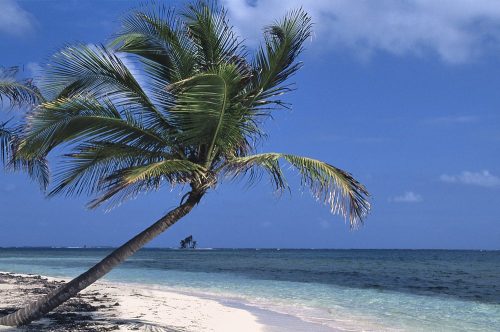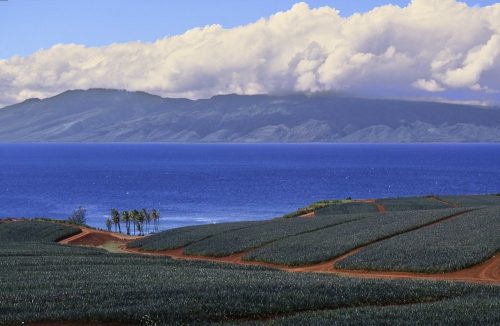 The San Blas Archipelago, off the northeastern coast of Panama, is home to the Kuna Yala—an indigenous people that inhabit its 365 coastal islands. The only way to truly experience the islands is by sailboat, and we sailed them for a month. They sell fruit, vegetables, and handmade mola textiles to the cruisers. Women wear mola blouses with patterned skirts, red and yellow head scarfs, arm and leg beads, long black lines down the nose, and often a gold nose ring. Taken while we were cruising Central America in our sailboat 2000-2001.
The San Blas Archipelago, off the northeastern coast of Panama, is home to the Kuna Yala—an indigenous people that inhabit its 365 coastal islands. The only way to truly experience the islands is by sailboat, and we sailed them for a month. They sell fruit, vegetables, and handmade mola textiles to the cruisers. Women wear mola blouses with patterned skirts, red and yellow head scarfs, arm and leg beads, long black lines down the nose, and often a gold nose ring. Taken while we were cruising Central America in our sailboat 2000-2001. A purple pastel sunset while at anchor in the San Blas Archipelago of Panama. Off the northeastern coast, the archipelago is home to the Kuna Yala—an indigenous people that inhabit its 365 coastal islands. The only way to truly experience the island is by sailboat, and we sailed the islands for a month. Image made while we were cruising Central America in our sailboat 2000-2001.
A purple pastel sunset while at anchor in the San Blas Archipelago of Panama. Off the northeastern coast, the archipelago is home to the Kuna Yala—an indigenous people that inhabit its 365 coastal islands. The only way to truly experience the island is by sailboat, and we sailed the islands for a month. Image made while we were cruising Central America in our sailboat 2000-2001. The San Blas Archipelago, off the northeastern coast of Panama, is home to the Kuna Yala—an indigenous people that inhabit its 365 coastal islands. Only the larger islands are inhabited. Coconuts are harvested on the smaller islands. A lone coconut palm leans to windward over white sand and turquoise water. Taken while we were cruising Central America in our sailboat 2000-2001.
The San Blas Archipelago, off the northeastern coast of Panama, is home to the Kuna Yala—an indigenous people that inhabit its 365 coastal islands. Only the larger islands are inhabited. Coconuts are harvested on the smaller islands. A lone coconut palm leans to windward over white sand and turquoise water. Taken while we were cruising Central America in our sailboat 2000-2001. The San Blas Archipelago, off the northeastern coast of Panama, is home to the Kuna Yala—an indigenous people that inhabit its 365 coastal islands. This lone fisherman worked in solitude as the quiet of the evening mist closed around him. Image taken while cruising the San Blas in our sailboat 2001.
The San Blas Archipelago, off the northeastern coast of Panama, is home to the Kuna Yala—an indigenous people that inhabit its 365 coastal islands. This lone fisherman worked in solitude as the quiet of the evening mist closed around him. Image taken while cruising the San Blas in our sailboat 2001. The San Blas Archipelago, off the northeastern coast of Panama, is home to the Kuna Yala—an indigenous people that inhabit its 365 coastal islands. The only way to truly experience the islands is by sailboat, and we sailed them for a month. Walking the beach on one of these many islands, I looked up to see this ketch gently illuminated by the setting sun. Shot while cruising the San Blas in our sailboat 2001.
The San Blas Archipelago, off the northeastern coast of Panama, is home to the Kuna Yala—an indigenous people that inhabit its 365 coastal islands. The only way to truly experience the islands is by sailboat, and we sailed them for a month. Walking the beach on one of these many islands, I looked up to see this ketch gently illuminated by the setting sun. Shot while cruising the San Blas in our sailboat 2001. The San Blas Archipelago, off the northeastern coast of Panama, is home to the Kuna Yala—an indigenous people that inhabit its 365 coastal islands. We sailed the archipelago for a month, snorkeling and exploring nearby islands. Rebecca painted this image, which is now in our home. Image made while we were cruising the San Blas in our sailboat 2001.
The San Blas Archipelago, off the northeastern coast of Panama, is home to the Kuna Yala—an indigenous people that inhabit its 365 coastal islands. We sailed the archipelago for a month, snorkeling and exploring nearby islands. Rebecca painted this image, which is now in our home. Image made while we were cruising the San Blas in our sailboat 2001. The San Blas Archipelago, off the northeastern coast of Panama, is home to the Kuna Yala—an indigenous people that inhabit its 365 coastal islands. We sailed the archipelago for a month. One day we found this little round little button of an island with white sand, one palm tree, and a grounded freighter in the background. So we decided to do a 'shipwrecked' triptych. Bekki donned a dress. I rowed her to the island in our dinghy, and then rowed away to photograph. That's trust! Images made while we were cruising the San Blas in our sailboat 2001.
The San Blas Archipelago, off the northeastern coast of Panama, is home to the Kuna Yala—an indigenous people that inhabit its 365 coastal islands. We sailed the archipelago for a month. One day we found this little round little button of an island with white sand, one palm tree, and a grounded freighter in the background. So we decided to do a 'shipwrecked' triptych. Bekki donned a dress. I rowed her to the island in our dinghy, and then rowed away to photograph. That's trust! Images made while we were cruising the San Blas in our sailboat 2001. The San Blas Archipelago, off the northeastern coast of Panama, is home to the Kuna Yala—an indigenous people that inhabit its 365 coastal islands. We sailed the archipelago for a month. One day we found this little round little button of an island with white sand, one palm tree, and a grounded freighter in the background. So we decided to do a 'shipwrecked' triptych. Bekki donned a dress. I rowed her to the island in our dinghy, and then rowed away to photograph. That's trust! Images made while we were cruising the San Blas in our sailboat 2001.
The San Blas Archipelago, off the northeastern coast of Panama, is home to the Kuna Yala—an indigenous people that inhabit its 365 coastal islands. We sailed the archipelago for a month. One day we found this little round little button of an island with white sand, one palm tree, and a grounded freighter in the background. So we decided to do a 'shipwrecked' triptych. Bekki donned a dress. I rowed her to the island in our dinghy, and then rowed away to photograph. That's trust! Images made while we were cruising the San Blas in our sailboat 2001. The San Blas Archipelago, off the northeastern coast of Panama, is home to the Kuna Yala—an indigenous people that inhabit its 365 coastal islands. We sailed the archipelago for a month anchoring at various islands, snorkeling, and exploring. I love this shot because of nature's tropical gradients from white sand to sky blue. Taken while we were cruising Central America in our sailboat 2000-2001.
The San Blas Archipelago, off the northeastern coast of Panama, is home to the Kuna Yala—an indigenous people that inhabit its 365 coastal islands. We sailed the archipelago for a month anchoring at various islands, snorkeling, and exploring. I love this shot because of nature's tropical gradients from white sand to sky blue. Taken while we were cruising Central America in our sailboat 2000-2001. This beautiful walkway along the beach can be found on Useppa Island—a little-known island located on the northern boundary of Pine Island Sound in Southwest Florida. Rising seas, around 4500 BC, disconnected Useppa from the mainland. Among other historical facts, the CIA used Useppa as its clandestine practice site for the failed Bay of Pigs invasion. Image #1 of 4.
This beautiful walkway along the beach can be found on Useppa Island—a little-known island located on the northern boundary of Pine Island Sound in Southwest Florida. Rising seas, around 4500 BC, disconnected Useppa from the mainland. Among other historical facts, the CIA used Useppa as its clandestine practice site for the failed Bay of Pigs invasion. Image #1 of 4. This beautiful walkway along the beach can be found on Useppa Island—a little-known island located on the northern boundary of Pine Island Sound in Southwest Florida. Rising seas, around 4500 BC, disconnected Useppa from the mainland. Among other historical facts, the CIA used Useppa as its clandestine practice site for the failed Bay of Pigs invasion. Image #2 of 4.
This beautiful walkway along the beach can be found on Useppa Island—a little-known island located on the northern boundary of Pine Island Sound in Southwest Florida. Rising seas, around 4500 BC, disconnected Useppa from the mainland. Among other historical facts, the CIA used Useppa as its clandestine practice site for the failed Bay of Pigs invasion. Image #2 of 4. This beautiful walkway along the beach can be found on Useppa Island—a little-known island located on the northern boundary of Pine Island Sound in Southwest Florida. Rising seas, around 4500 BC, disconnected Useppa from the mainland. Among other historical facts, the CIA used Useppa as its clandestine practice site for the failed Bay of Pigs invasion. Image #3 of 4.
This beautiful walkway along the beach can be found on Useppa Island—a little-known island located on the northern boundary of Pine Island Sound in Southwest Florida. Rising seas, around 4500 BC, disconnected Useppa from the mainland. Among other historical facts, the CIA used Useppa as its clandestine practice site for the failed Bay of Pigs invasion. Image #3 of 4.








